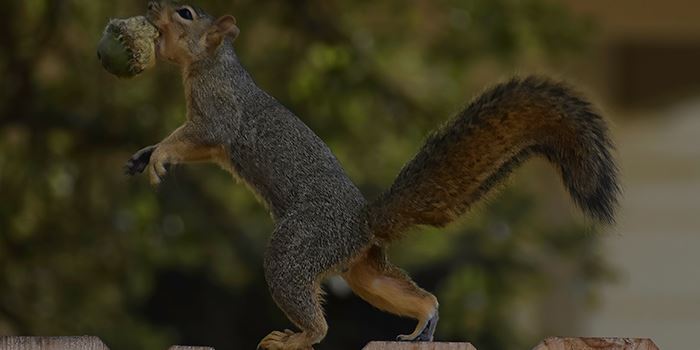Squirrelly Strategists

By Karen Menard
A day in the life of a squirrel on a mission--gather, hoard, repeat.
Except, the process just isn’t quite that simple, because squirrels are bent on stashing massive amounts of food--sometimes up to 3,000 nuts in a season.
Most recognized during the autumn for their scatterbrained, indecisive maneuvers that seem to occur right in the path of our vehicles--these rodents are busy. Yet, as unsystematic as their antics seem, studies show that squirrels harbor a type of strategic intelligence when it comes to their winter caches. Mammalian instinct alerts them to the fact that the winter is approaching and food will be scarce, so they scurry around focused on stocking their subterranean pantries--but, with game.
Depending on the species, hoarding can be achieved using different methods. Red squirrels practice “larder” hoarding in which pine cones or tulip tree seeds, acorns, nuts etc., are amassed in one, fiercely protected location, usually in the middle of their territory. Anybody or anything approaching too closely will be warned loudly with a series of screams, chatters, and rattles.
Eastern fox squirrels “scatter” hoard, meaning that they disperse and bury (or cache) their treasures in locations where they can best access them close to home. These small, scattered caches that result from this strategy lower the risk of losing a high percentage of food to other bushy-tailed pilferers.
As fall and winter approaches, the need for more cognitive capacity is increased and squirrel survival mode kicks into gear. In order to achieve success, both memory and burial tactics come into play. Lucky for the squirrel--the hippocampus, a part of the brain involved with memory, actually expands by about twenty percent during the cold weather season.
So, to increase this likelihood of remembering where each nut is placed, weeks later, fox squirrels have been shown to use what is called “spatial chunking” where they sort, organize and bury their food according to type. And, any morsel falling into the most coveted snack category, often gets buried farther away from its source at a lower density in order to evade other furry, peanut pirates.
In addition, they may also engage the use of spatial and visual cues, like familiarizing themselves with the locations of nearby trees and shrubs, before relying much on their sense of smell.
This winter season, take some time to watch how these interesting animals are able to relocate their caches of food near a Window on Wildlife, along a trail or in your neighborhood.
---
Did you know?
Squirrels are always aware that others may be watching them hide food. To fool onlookers, they have been known to engage in “deceptive caching,” where they will dig a hole, pretend to bury the food and then quickly take off to actually cache it at another location.